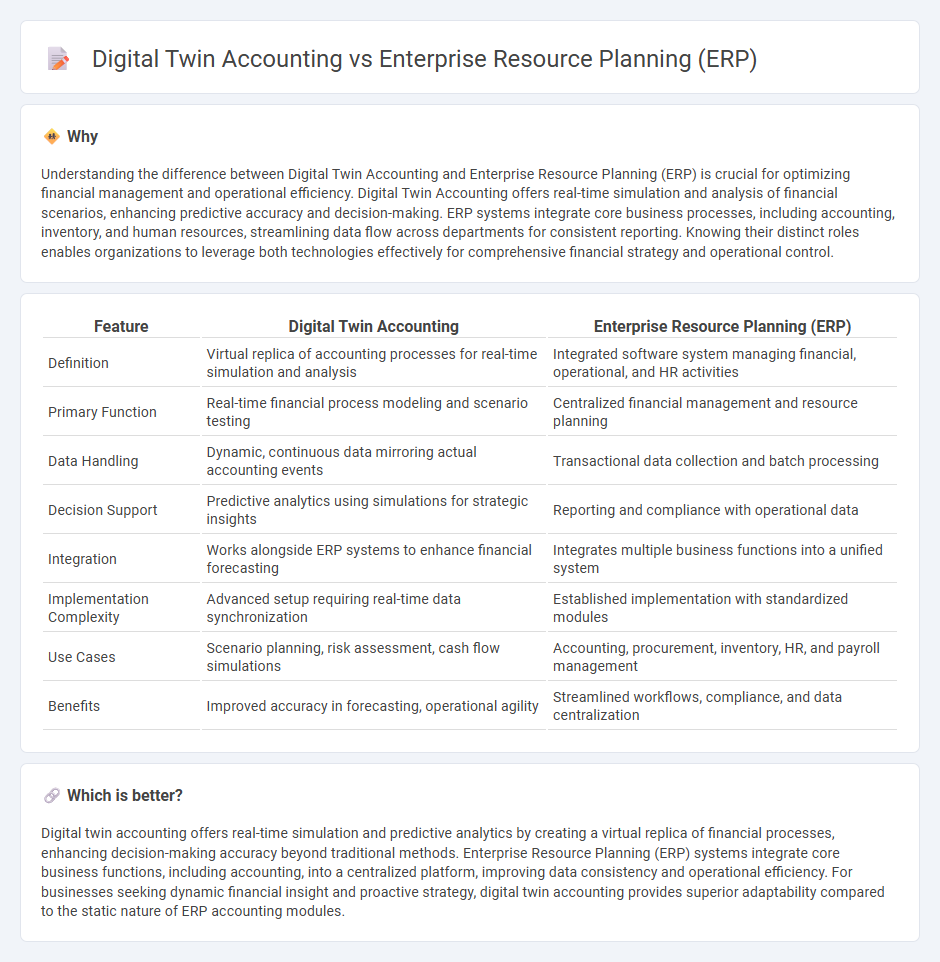
Digital twin accounting integrates real-time financial data with dynamic virtual models to enhance accuracy and forecasting compared to traditional Enterprise Resource Planning (ERP) systems, which primarily focus on consolidating historical financial transactions and operational data. By simulating business processes and financial scenarios, digital twin accounting enables proactive decision-making and risk management within organizations. Explore how digital twin accounting transforms financial operations and complements ERP solutions for comprehensive enterprise management.
Why it is important
Understanding the difference between Digital Twin Accounting and Enterprise Resource Planning (ERP) is crucial for optimizing financial management and operational efficiency. Digital Twin Accounting offers real-time simulation and analysis of financial scenarios, enhancing predictive accuracy and decision-making. ERP systems integrate core business processes, including accounting, inventory, and human resources, streamlining data flow across departments for consistent reporting. Knowing their distinct roles enables organizations to leverage both technologies effectively for comprehensive financial strategy and operational control.
Comparison Table
| Feature | Digital Twin Accounting | Enterprise Resource Planning (ERP) |
|---|---|---|
| Definition | Virtual replica of accounting processes for real-time simulation and analysis | Integrated software system managing financial, operational, and HR activities |
| Primary Function | Real-time financial process modeling and scenario testing | Centralized financial management and resource planning |
| Data Handling | Dynamic, continuous data mirroring actual accounting events | Transactional data collection and batch processing |
| Decision Support | Predictive analytics using simulations for strategic insights | Reporting and compliance with operational data |
| Integration | Works alongside ERP systems to enhance financial forecasting | Integrates multiple business functions into a unified system |
| Implementation Complexity | Advanced setup requiring real-time data synchronization | Established implementation with standardized modules |
| Use Cases | Scenario planning, risk assessment, cash flow simulations | Accounting, procurement, inventory, HR, and payroll management |
| Benefits | Improved accuracy in forecasting, operational agility | Streamlined workflows, compliance, and data centralization |
Which is better?
Digital twin accounting offers real-time simulation and predictive analytics by creating a virtual replica of financial processes, enhancing decision-making accuracy beyond traditional methods. Enterprise Resource Planning (ERP) systems integrate core business functions, including accounting, into a centralized platform, improving data consistency and operational efficiency. For businesses seeking dynamic financial insight and proactive strategy, digital twin accounting provides superior adaptability compared to the static nature of ERP accounting modules.
Connection
Digital twin accounting integrates real-time financial data simulations with Enterprise Resource Planning (ERP) systems to enhance decision-making accuracy and operational efficiency. By mirroring financial processes digitally, it enables continuous monitoring and predictive analytics within ERP platforms, optimizing resource allocation and risk management. This synergy streamlines accounting workflows and improves financial transparency across the enterprise.
Key Terms
Integration
Enterprise Resource Planning (ERP) systems centralize financial, operational, and human resource data, enabling seamless integration across business units for real-time reporting and decision-making. Digital twin accounting mirrors physical and digital processes, providing dynamic simulation and predictive analytics to optimize financial workflows and enhance integration with ERP platforms. Explore how combining ERP and digital twin accounting can revolutionize your enterprise's data integration strategy.
Real-time data
Enterprise Resource Planning (ERP) systems integrate core business processes by providing centralized real-time data management across departments such as finance, supply chain, and human resources. Digital twin accounting utilizes real-time data to create a virtual replica of financial operations, enabling dynamic scenario analysis and predictive insights for enhanced decision-making. Explore further to understand how these technologies transform financial management through real-time data integration.
Process automation
Enterprise Resource Planning (ERP) systems streamline process automation by integrating core business functions such as finance, supply chain, and human resources into a single platform, enabling real-time data processing and operational efficiency. Digital twin accounting enhances process automation by creating a virtual replica of financial systems that allows continuous simulation, analysis, and optimization of accounting workflows, improving accuracy and predictive capabilities. Discover the key differences and benefits of each approach to optimize your enterprise process automation strategies.
Source and External Links
Enterprise resource planning - Wikipedia - ERP is integrated management software that consolidates key business processes in real time across functions like manufacturing, purchasing, sales, and accounting, facilitating data sharing and planning across an organization through a common database system.
What is Enterprise Resource Planning (ERP)? - IBM - ERP is business management software designed to automate and integrate all parts of a company's workflows and functions -- including finance, supply chain, HR, and project management -- using modular applications connected via a single database to streamline operations.
What is ERP? A Comprehensive Guide - NetSuite - ERP systems automate business processes by centralizing data from various departments like accounting, manufacturing, and marketing into a common database, enabling greater visibility, analytics, and operational efficiency, and offering deployment options including cloud, on-premises, or hybrid models.
 dowidth.com
dowidth.com